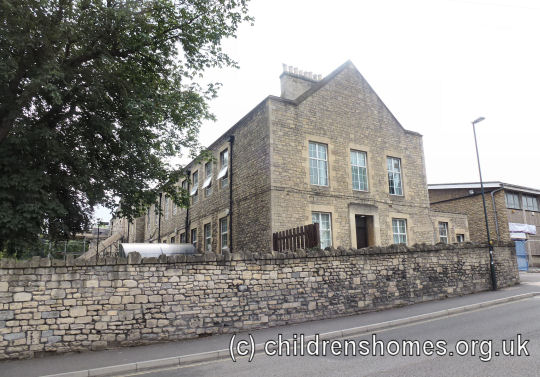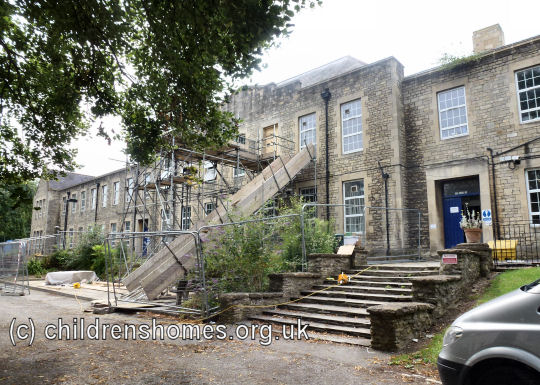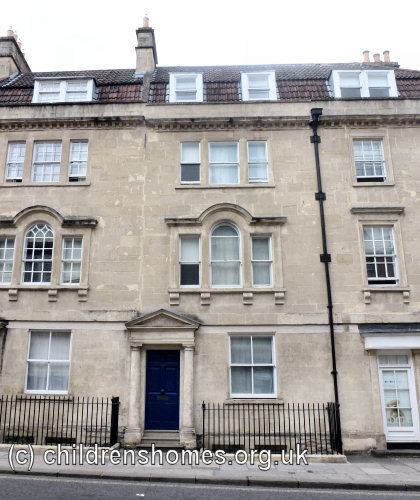Somerset Industrial Home for Boys, Bath, Somerset
The Somerset Industrial Home for Boys (also known as the Somerset Boys' Home) was established in 1866 at Bath, largely due to the efforts of Mr Osborn, the chaplain to the Bath gaol. Its aim was stated as being 'to reclaim abandoned boys, and to rescue those whose unhappy circumstances would inevitably lead them to crime and profligacy'. On July 19th, 1866, the Home was formally certified to operate as an Industrial School at Devonshire House, Wells Road (sometimes referred to as Devonshire Road), Bath. There was considerable opposition in the neighbourhood to the School being sited there. The managers agreed that they would move the establishment to a new location, although it was to take fifteen years for this to happen.
The School's first superintendent was Mr Chevins, formerly schoolmaster at the Warwickshire Reformatory and then master of the Havannah Training Ship at Cardiff. Mrs Chevins was appointed as matron.
In 1868, the School buildings were found to be in so dangerous a condition that it was necessary to remove the boys for a time, while they were repaired and strengthened. Temporary accommodation was found for them in two cottages belonging to Mr Sheppard, at Bathampton.

Devonshire House, Wells Road, Bath, 2014. © Peter Higginbotham
The boys' industrial training included knitting stockings and tailoring. In 1869, a seven-acre field, located a mile from the School, was rented for to provide additional employment. In 1872, it was reported that a twenty-acre farm was now attached to the School. The older boys were also employed by local farmers. The superintendent and matron were now Mr and Mrs Donald Young. Like his predecessor, Mr Young had previously been master of the Havannah Training Ship.
At an inspection in August, 1877, it was discovered that the foundations of the School premises were unsound and that the external walls were leaning over. Accordingly, the mangers of the establishment began to look for new premises. In the lack of other alternatives, the School was offered the use of the Bath's old City Prison which was standing unoccupied. This continued until 1881 when the School moved into the old militia barracks on Lower Bristol Road, Twerton. The site was certified for the accommodation of 180 boys. The building and its accompanying ground were considered ideal for the purpose. A School band was now started.

Former Somerset Industrial Home for Boys, Twerton, Bath, 2014. © Peter Higginbotham

Former Somerset Industrial Home for Boys, Twerton, Bath, 2014. © Peter Higginbotham
On October 24th, 1882, the School opened an Auxiliary Home for working boys at 32 St. James' Parade, Bath. The home provided a supervised hostel for up to eight boys who were leaving the main School and taking up work with local employers. In September, 1883, the establishment was relocated to 16 Albert Buildings, (Victoria) Bridge Road, Bath, with accommodation for ten boys.

Former Somerset Working Boys Home, St James' Parade, Bath, 2014. © Peter Higginbotham
A report in 1897 noted that School now had 63 acres of land, located about two miles away, which were cultivated as a farm and market garden, The livestock included 6 cows, 4 horses, a pony, and 200 poultry birds. There was a shop in the town for the sale of produce from the farm. The allocation of boys to various work tasks included 12 on the market garden and farm, 40 to 50 doing outside work, 7 tailors, 7 shoemakers, 2 bakers, 2 carpenters, 2 cow-boys, 2 stable boys, 1 looking after pigs, 5 shop-boys, 14 to 20 in the needle-room, and 15 in the band. The playing field in front of the School was used for football and cricket and matches with outside teams were arranged. A large playroom was fitted up with lockers and used in winter as a gymnasium, and in summer as a reading room. In the winter, physical and military drills were given, and magic lantern shows were arranged. A mark system was in operation carrying monetary rewards for good behaviour. Boys who had friends living near were allowed from time to time, if well-behaved, to visit them. Good-conduct boys were also allowed to work out of the school, free of the supervision of the School officials.
On 30th November, 1910, Mrs and Mrs Young resigned as superintendent and matron after 38 years in their posts. They were succeeded by their son, John George Young, and his wife Harriet.
The School formally ceased operation on June 17th, 1929. From 1934, the site was occupied by Bath's Domestic Science and Technical College from 1934. In more recent times, it has been home to Hayesfield School for Girls.
Records
Note: many repositories impose a closure period of up to 100 years for records identifying individuals. Before travelling a long distance, always check that the records you want to consult will be available.
- Somerset Heritage Centre, Brunel Way, Langford Mead, Norton Fitzwarren, Taunton TA2 6SF. Holdings include: Admission registers (1866-1929); Birth certificates of inmates (1867-1905); Printed rules of management (1866).
Census
Bibliography
- Higginbotham, Peter Children's Homes: A History of Institutional Care for Britain's Young (2017, Pen & Sword)
- Mahood, Linda Policing Gender, Class and Family: Britain, 1850-1940 (1995, Univeristy of Alberta Press)
- Prahms, Wendy Newcastle Ragged and Industrial School (2006, The History Press)
Links
- None noted at present.
Except where indicated, this page () © Peter Higginbotham. Contents may not be reproduced without permission.


